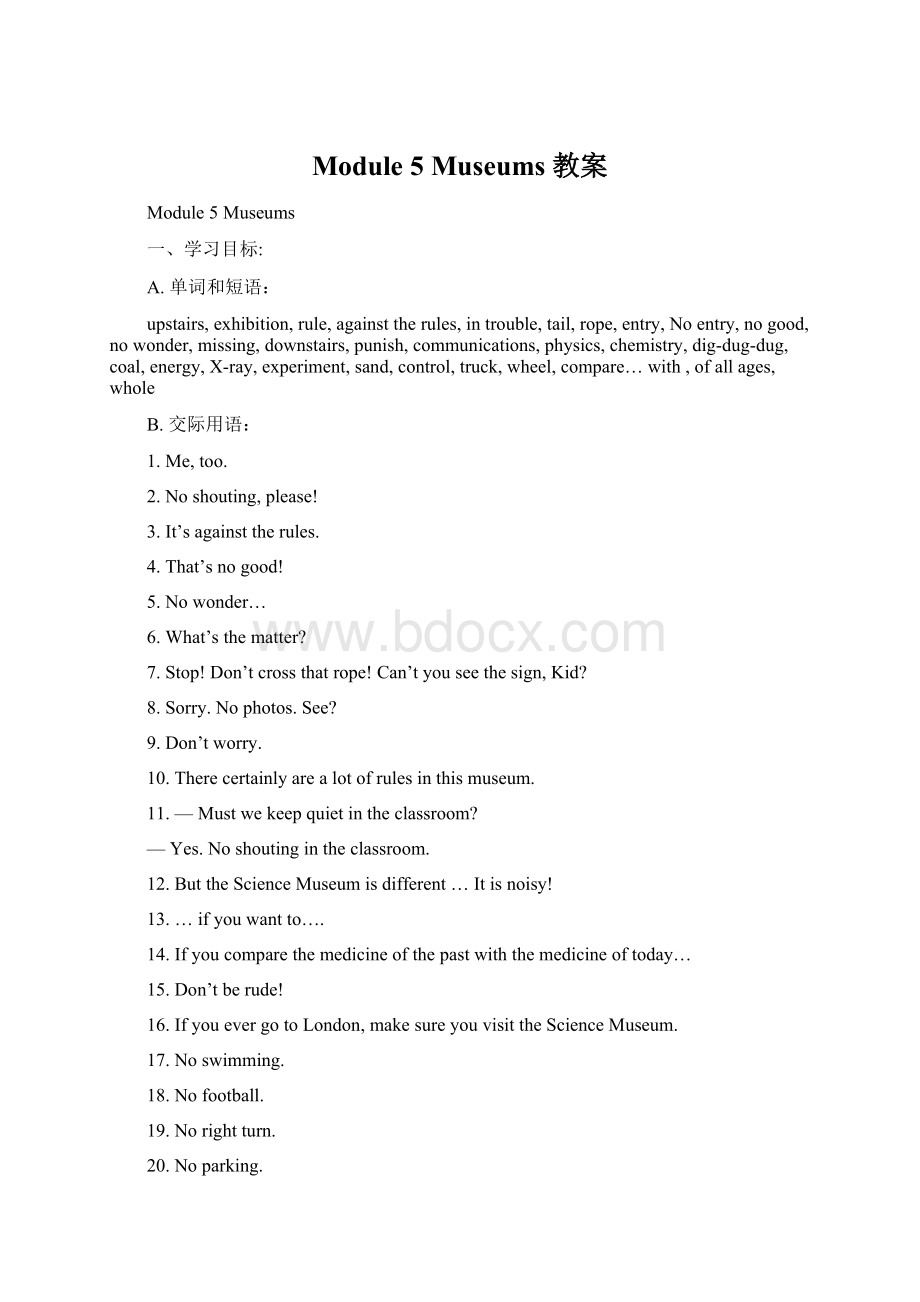 Module 5 Museums 教案Word格式文档下载.docx
Module 5 Museums 教案Word格式文档下载.docx
- 文档编号:19187688
- 上传时间:2023-01-04
- 格式:DOCX
- 页数:18
- 大小:297.70KB
Module 5 Museums 教案Word格式文档下载.docx
《Module 5 Museums 教案Word格式文档下载.docx》由会员分享,可在线阅读,更多相关《Module 5 Museums 教案Word格式文档下载.docx(18页珍藏版)》请在冰豆网上搜索。

16.IfyouevergotoLondon,makesureyouvisittheScienceMuseum.
17.Noswimming.
18.Nofootball.
19.Norightturn.
20.Noparking.
21.Nolittering.
22.Nofoodanddrinks.
二.教学目标
1.Function:
Talkingaboutrules.
2.Structure:
Imperativesentences;
adverbialclause:
if…do.
3.Skills:
1)Listeningandunderstandingspecificinformation.
2)Describingandunderstandinglongsentences.
3)Readingforspecificinformationandtakingnotes.
4)Describingamuseumbyusingnotesandidentifyingandusingreferencewordsit,they,there.
4.Aroundtheworld:
TheLouvre.
5.Task:
Planningaguidetoamuseum.
三、重点及难点:
Grammar:
if…do…
四、教学设计:
Unit1Don’tcrossthatrope!
ⅠTeachingmodel
Listeningandspeaking
ⅡTeachingmethod
Communicationapproach
ⅢTeachingaims
1.Tolistenandunderstandthesentencesgivinginstructions;
2.Tounderstandtheconversation;
3.Tolearntouseimperativesentencesandmodalverbstogiveinstructions.
ⅣTeachingObjectives
Keyvocabulary:
upstairs,exhibition,rule,againsttherule,introuble,tail,rope,entry,Noentry,nogood,nowonder,missing,downstairs,punish
ⅤTeachingaids
Taperecorder,picture,OHP,video
ⅥTeachingSteps
Step1Warming-up
1.Showsomepicturesofthesigns.
2.Learnthenewwords.
Step2Listeningandvocabulary
FinishActivity1onpage34.
1.AskthestudentstolookatthepicturesontherightinActivity1.
2.Readthroughthenamesofthesigns.
1)Don’ttouch.2)Nosmoking.3)Noshouting.4)Nophotos.
3.Matchthesignswiththerules.
4.Checktheanswers.
5.Nowworkinpairs.Tellyourpartnertherules.
Step3Listenandanswerthequestions.
1.Askthestudentstoreadthroughthequestions.
1)WheredidLinglingfindtheguide?
2)HowmanypeoplearegoingtothemuseumonSaturday?
2.Playtherecordingandaskthestudentstolistencarefully.
3.Listenandanswerthequestions.
Step4Listenandread
1.Playtherecordingandaskthestudentstoanswerthequestions.
1)Whatroomdothechildrenwanttovisit?
2)Aretherelotsofpeopleinthemuseum?
2.Check(√)therulesmentionedintheconversation.
1)AskthestudentstolookatthepicturesinActivity3.
2)Readtheconversationagain.
3)Check(√)therulesmentionedintheconversation
4)Checktheanswers.
3.Readtheconversationagainandfindmainpoints.
Step5Writing
1.Writedownwhatyoucannotdointhemuseum.
Noshouting.
2.Completethepassagewiththewordsinthebox.
downstairsexhibitionmissingpunishroperulestailupstairs
1)AskthestudentstoreadthroughthepassageinActivity5.
LinglingandBettyneededsomeinformationfortheirprojects,sotheywantedtogo
(1)___________totheAnimalRoom,butDaminggotintotroubleatthemonkey
(2)___________.Damingbrokethe(3)___________byshoutingandtryingtocrossthe(4)___________whenheplannedtoseeamonkeywithalong(5)___________.ThentheydiscoveredthatLingling’smobilephonewas(6)___________.Theguardtoldthemtogo(7)___________tothelostandfoundoffice.Linglinghastofindherphone,orhermotherwill(8)___________her.
3)Completethepassagewiththewordsinthebox.
Step6.Learn“EverydayEnglish”
Metoo.
Noshouting,please!
It’sagainsttherules.
That’snogood!
Nowonder…
Step7Languagepoints
1.Noshouting,please!
请勿喧哗!
Don’tcrossthatcrop!
不要越过那条绳子!
Nophotos.请勿拍照。
表示“禁止做某事”。
主要结构:
1)No+动名词
Nofishing.禁止垂钓。
Noparking.禁止停车。
2)No+名词
Noentry.请勿入内。
Nofoodanddrinks.请勿饮食。
3)祈使句
Don’tmakeanynoise.不要吵闹。
Keepoffthegrass.请勿践踏草坪。
2.It’sagainsttherules.
这违反了规定。
against是介词,表示“对抗,违背,相反”,句中againsttherules作句子的表语。
该词可以构成很多词组。
如:
Whoareyouplayingagainstinthenextmatch?
下一场比赛你们和谁对抗?
3.Thatphoneisnew!
Ihavetofindit,orMumwillpunishme!
那部电话是新的。
我一定要找到它,否则妈妈会惩罚我的。
punishv.惩罚;
惩处
常用结构:
punishsb.forsth./doingsth.
e.g.Hewaspunishedforbeinglate.
他因迟到而受到处罚。
5.It’smissing!
它丢了!
missingadj.找不到的;
失踪的
辨析:
lost/missing/gone
三者都可表“失去”。
lost是广义的“丢失”,包含可找回和不能找回的意思;
missing强调某物或某人暂时找不着了(含最终可能找到之意);
gone的含义最广,包括“(东西)没了;
(时间)过去了;
(人)死了”等,而且语气肯定。
[运用]
1)______timewillneverbefoundagain.
2)Someonereportedtothepolicethatachildwas________.
3)Theoldtimesare______forever.
Step8Pronunciationandspeaking
1.Playtherecordingoncewithoutstopping.
2.Playtherecordingagainandaskthewholeclasstorepeat.
1)Noshouting,please!
It’sagainsttherules.
2)Becauseit’sclosed.
3)Therecertainlyarealotofrulesinthismuseum.
3.Askthestudentstolistenandunderlinethewordsthespeakerstresses.
4.Nowlistenagainandrepeat.
Step9Discussion
1.Readthroughtheexamplewiththeclass.
—Mustwekeepquietintheclassroom?
2.Discusstherulesinyourclassroom.
3.Workinpairs.
Step10Exercises
Step11Homework
1.RememberthewordsandphrasesinUnit1.
2.Finishtheexercisesintheworkbook.
Unit2IfyouevergotoLondon,makesureyouvisittheScienceMuseum.
Readingandwriting.
Bottom-upapproach
1.Tounderstandthepassage;
2.Togetthemainideaofeachparagraph;
3.Tolearntousepronounscorrectlyinwriting.
communications,physics,chemistry,dig-dug-dug,coal,energy,X-ray,experiment,sand,control,truck,wheel,compare…with/to,ofallages,whole
OHP,multi-media
Step1Warmingup
1.AskthestudentstolookatthepicturesinActivity1.
2.Talkaboutthepictures.
3.Lookatthepicturesandtalkaboutthedifferencesbetweenthetwomuseums
Step2Readingandvocabulary
1.IntroducetheScienceMuseuminLondonandshowsomepictureandvideos.
2.Askthestudentstoreadthroughthepassageandanswerthequestion.
HowistheScienceMuseumdifferentfromothermuseums?
3.Learnsomenewwords.
Step3Completethetable.
1.Readthepassageagain.
2.CompletetheTony’sfavouritemuseumcolumninthetable.
Tony’sfavouritemuseum
Yourfavouritemuseum
Name
Place
Favouriteroom
Openinghours
Price
3.Checktheanswers.
Step4Answerthequestions.
1.AskthestudentstoreadthewordsintheboxinActivity4.
chemistrycommunicationscontrolenvironmentexperimentphysicsX-ray
2.AskthestudentstoreadthroughthequestionsinActivity4.
1)Whatcanyoulearnaboutintheroomsonthesecondandthirdfloors?
2)Whatallowsyoutoseeinsideyourbody?
3)WhatcanyoudointheLaunchpad?
4)Whatcanyoulearnaboutonthefourthandfifthfloors?
3.Finishthetask.
Step5Languagepoints
1.…ifyouwanttofillabagwithsand,youhavetocontrolakindoftrackonwheelsandmoveitintothecorrectplace.…
如果你想将袋子装满沙子,你得操控一种带轮子的运输车,并把车移动到正确的位置。
fill…with…表示“用…装满…”。
例如:
Theteacherfilledabottlewithwater.老师在瓶子里注满了水。
controlv.操作;
操纵
e.g.Youcancontrolthemachine.
你可以操纵那台机器。
2.Ifyoucomparethemedicineofthepastwiththemedicineoftoday…
如果你比较一下过去的药物与现在的药物…
compare…with…表示“拿…和…作比较”。
Mr.WulikestocompareClassThreewithClassFive.
吴老师喜欢拿三班和五班作比较。
3.TheScienceMuseumisinterestingforpeopleofallages.
科学博物馆非常有趣,可以说老少皆宜。
ofallages所有年龄段的
e.g.Peopleofallagesvisitthemuseum.
男女老少都来参观这个博物馆。
4.Itismyfavouritemuseuminthewholeworld!
这是我在整个世界上最喜欢的博物馆!
all和whole都可用作形容词,意为“整个的;
全部的”,但在句中的位置不同。
all通常位于定冠词、指示代词及物主代词之前;
whole通常位于定冠词、指示代词及物主代词之后。
e.g.Allthefamily/Thewholefamilyenjoytakingvacations.
所有的家庭都喜欢度假。
I’mverybusyallthisweek/thiswholeweek.
我整周都很忙。
Step6Writing
2.Decidewhattheunderlinedwordsinthesentencesreferto.
1)ButtheScienceMuseumisdifferent…Itisnoisy!
2)Peopletalkaboutwhattheycanseeanddohere.
3)Youcanalwaysfindsomethingnewandhaveawonderfultimethere.
4.Learningtolearn.
Whenyouwrite,youcanusepronounssuchasit,he,her,this,there…toavoidrepetition.Butremembertocheckwhetherthereferenceisclearornot.
5.AskthestudentstoreadthroughthepassageinActivity6.
TherearealotofmuseumsinLondon,andoneofthemostpopularistheBritishcanseelotsofinterestingthingsfromdifferenttimesandplaces.TheBritishMuseumisverytraditional.Visitorsmustnotmakeanoise,and(3)__________mustnottouchanythingortakephotos.Entrytothemuseumisfree,sopeoplecanvisit(4)________asoftenastheylike.
6.Completethepassagewithit,theyandthere.
7.Checktheanswers.
Step7Exercises
Step8Writtentask
Writeapassageaboutyourfavouritemuseum.Payattentiontothewordsit,theyandthere.
Completethe
- 配套讲稿:
如PPT文件的首页显示word图标,表示该PPT已包含配套word讲稿。双击word图标可打开word文档。
- 特殊限制:
部分文档作品中含有的国旗、国徽等图片,仅作为作品整体效果示例展示,禁止商用。设计者仅对作品中独创性部分享有著作权。
- 关 键 词:
- Module Museums 教案
 冰豆网所有资源均是用户自行上传分享,仅供网友学习交流,未经上传用户书面授权,请勿作他用。
冰豆网所有资源均是用户自行上传分享,仅供网友学习交流,未经上传用户书面授权,请勿作他用。


 对中国城市家庭的教育投资行为的理论和实证研究.docx
对中国城市家庭的教育投资行为的理论和实证研究.docx
